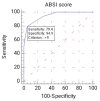Emergency Care for Burn Patients-A Single-Center Report
- PMID: 36836472
- PMCID: PMC9959911
- DOI: 10.3390/jpm13020238
Emergency Care for Burn Patients-A Single-Center Report
Abstract
Burns, one of the main public health problems, lead to significant mortality and morbidity. Epidemiological studies regarding burn patients in Romania are scarce. The aim of this study is to identify the burn etiology, demographics, clinical characteristics, and outcomes in patients requiring treatment in a regional burn unit.
Design: We performed a retrospective observational study of 2021.
Patients: All patients admitted to our six-bed intensive care unit (ICU) were included.
Interventions: The following data were collected for further analysis: demographics, burn pattern (etiology, size, depth, affected body region), type of ventilation, ABSI (Abbreviated Burn Severity Index) score, comorbidities, bioumoral parameters, and hospitalization days.
Results: There were 93 burned patients included in our study that were divided into two groups: alive patients' group (63.4%) and deceased patients' group (36.6%). The mean age was 55.80 ± 17.16 (SD). There were 65.6% male patients, and 39.8% of the patients were admitted by transfer from another hospital. Further, 59 patients presented third-degree burns, from which 32.3% died. Burns affecting >37% of the total body surface area (TBSA) were noticed in 30 patients. The most vulnerable regions of the body were the trunk (p = 0.003), the legs (p = 0.004), the neck (p = 0.011), and the arms (p = 0.020). Inhalation injury was found in 60.2% of the patients. The risk of death in a patient with an ABSI score > 9 points was 72 times higher. Comorbidities were present in 44.1% of the patients. We observed a median LOS (length of stay) of 23 days and an ICU-LOS of 11 days. Logistic regression analysis showed that admission protein, creatinkinase, and leukocytes were independent risk factors for mortality. The general mortality rate was 36.6%.
Conclusion: A thermal factor was responsible for the vast majority of burns, 94.6% of cases being accidents. Extensive and full-thickness burns, burns affecting the arms, inhalation injuries, the need for mechanical ventilation, and a high ABSI score represent important risk factors for mortality. Considering the results, it appears that prompt correction of protein, creatinkinase, and leukocytes levels may contribute to improvement in severe burn patients' outcomes.
Keywords: burn etiology; burn injury; epidemiology; outcome; regional burn unit.
Conflict of interest statement
The authors declare no conflict of interest.
Figures







Similar articles
-
[Epidemiological characteristics and outcome analysis of 266 patients with inhalation injuries combined with total burn area less than 30% total body surface area].Zhonghua Shao Shang Za Zhi. 2021 Apr 20;37(4):340-349. doi: 10.3760/cma.j.cn501120-20200229-00106. Zhonghua Shao Shang Za Zhi. 2021. PMID: 33887882 Free PMC article. Chinese.
-
Estimating severity of burn in children: Pediatric Risk of Mortality (PRISM) score versus Abbreviated Burn Severity Index (ABSI).Burns. 2013 Sep;39(6):1048-53. doi: 10.1016/j.burns.2013.05.001. Epub 2013 Jun 13. Burns. 2013. PMID: 23768709
-
Clinical characteristics and risk factors for severe burns complicated by early acute kidney injury.Burns. 2020 Aug;46(5):1100-1106. doi: 10.1016/j.burns.2019.11.018. Epub 2019 Dec 13. Burns. 2020. PMID: 31839503
-
Acute kidney injury in burn patients admitted to the intensive care unit: a systematic review and meta-analysis.Crit Care. 2020 Jan 2;24(1):2. doi: 10.1186/s13054-019-2710-4. Crit Care. 2020. PMID: 31898523 Free PMC article.
-
A scoping review of burn care in Southeast Asia.Br J Community Nurs. 2023 Mar 2;28(Sup3):S24-S34. doi: 10.12968/bjcn.2023.28.Sup3.S24. Br J Community Nurs. 2023. PMID: 36809899
Cited by
-
Association of the abbreviated burn severity index with mortality in severely burned patients: A meta-analysis.PLoS One. 2025 Feb 20;20(2):e0319199. doi: 10.1371/journal.pone.0319199. eCollection 2025. PLoS One. 2025. PMID: 39977408 Free PMC article.
-
Emergency Treatment of Burns in Adults-Characteristics of Adult Patients and Acute/Pre-Hospital Burn Management.Eur Burn J. 2025 Apr 10;6(2):19. doi: 10.3390/ebj6020019. Eur Burn J. 2025. PMID: 40265374 Free PMC article.
-
Epidemiological Characteristics of Hospitalized Burn Patients-A 10-Year Retrospective Study in a Major Burn Center in Serbia.Life (Basel). 2025 Jan 17;15(1):118. doi: 10.3390/life15010118. Life (Basel). 2025. PMID: 39860058 Free PMC article.
-
Immobilization of Bacteriophages in Ex Tempore Hydrogel for the Treatment of Burn Wound Infection.Gels. 2023 Aug 3;9(8):625. doi: 10.3390/gels9080625. Gels. 2023. PMID: 37623080 Free PMC article.
References
LinkOut - more resources
Full Text Sources

